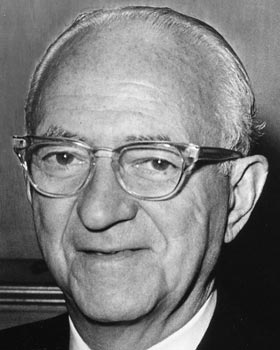
Jules Stein, MD: An Ophthalmology A-Lister
With the ASCRS/ASOA conference in Los Angeles just around the corner, we honor the legacy of Jules Stein, MD. Generations before us knew him
as a pioneer in Hollywood entertainment, but he was also a p”eye”oneer in the fight
to prevent blindness. While his accomplishments were anything but, a
brief look at his path shows he was one of the most influential contributors to
ophthalmic research and advancements.
Jules Stein was an Indiana boy who, as a young musician playing
in Chicago nightclubs and speakeasies, rubbed shoulders with the likes of Al
Capone and Mae West, all while pursuing his education at University of Chicago
and Rush Medical School. He subsequently studied at the University of Vienna
and later returned to Chicago to complete his ophthalmology residency at Cook
County Hospital. He began his medical career in an ophthalmology practice in
Chicago as he simultaneously booked musical groups around Chicago (between appointments!). Soon, as his “side”
business flourished, he took a leave of absence from the medical practice to
try his hand full time in the music industry forming Music Corporation of
America (MCA).
MCA represented the biggest radio names of the day, such as
Benny Goodman, Tommy Dorsey and Guy Lombardo. Before long, MCA grew into an
influential agency representing film stars as well, like Judy Garland, Betty
Grable, Bob Hope, Marlon Brando, and Marilyn Monroe. As televisions were
popping up in living rooms across America, MCA began producing thousands of
hours of programming each year. With the purchase of Decca Records and
Universal Studios, what started as a way to pay for college had become the
world’s largest entertainment empire dominating every aspect of entertainment.
Now fully established as Hollywood elite, Dr. Stein turned
his focus back to his first love…helping people see. This led to the endowment
Research to Prevent Blindness (RPB) in 1961, which, most recently, in 2016
awarded $5.4 million in grants, bringing since its inception more than $346
million into eye research in over 40 institutions. Next, his pledge of $1.25M
to UCLA for the construction of an institution dedicated solely to eye research
and treatment initiated what was to become the largest project of its kind,
which now bears his name and is consistently ranked as one of the top
ophthalmology hospitals in the country. Dr. Stein’s mission continued with a
hard-won battle to establish the National Eye Institute as part of the National
Institutes of Health, which has provided billions in funding for eye research.
The scientific findings and advancements resulting from these institutions are
countless and have improved the lives of millions.
As surgeons and researchers gather at ASCRS/ASOA to further
education and share ideas, we should remember Dr. Jules Stein for bringing the
importance of eye health research into the spotlight and setting the stage for
much of the ophthalmic technology we see today.
Credits: Jules Stein, MD - Ophthalmologist, Entertainment Magnate, and Advocate for Vision. Bradley R. Straatsma, MD, JD; David F. Weeks. American Academy of Ophthalmology, Vol. 123, No. 4, April 2016
UCLA History - alumni.ucla.edu/ucla-history/ucla-history-50
www.rpbusa.org
https://nei.nih.govn
Have a thought about this article? Contact Us and let us know.